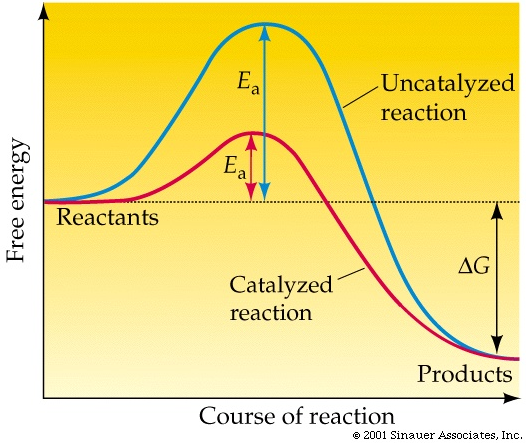The community dashboard is a research and analysis project. The goal is to help the team bring rigor to its goal-setting and also to give us a means of measuring success over time.
There are many successful communities within Red Hat, Fedora, and JBoss, and those communities have been built by many different people. The Community Architecture team wants to understand how these communities are created, and how we ensure that every member of Red Hat, Fedora, and JBoss is capable of creating and leading a successful community.
Background
Community Biology 101
Community serves as a catalyst in everything that Red Hat, Fedora, and JBoss does.
 http://www.columbia.edu/cu/biology/courses/c2005/purves6/figure06-14.jpg
http://www.columbia.edu/cu/biology/courses/c2005/purves6/figure06-14.jpg
Reaction: The progress of any task from idea to reality. The task can be as simple as a one-page summary of Fedora 10 for the press, or as complicated as the feature planning process for Fedora 11. The task can be code, leadership, process documentation, testing, writing, artwork, etc.
For any reaction to complete requires some amount of energy. From a business point of view, energy, time, and money are all synonymous.
The blue curve represents a reaction that does not operate with a community-building mindset. Perhaps this is a proprietary software project, and community isn't even an option. Perhaps it is an open source upstream that is so focused on coding, it doesn't have the time to properly build a community. Either way, the amount of energy required to reach a successful end state is high.
The red curve represents a reaction that does operate with a strong community. Whether it is a Fedora sub-project, Fedora as a whole, the RPM upstream, OLPC, or an emerging technology like Cobbler or Func is irrelevant.
Note that both reactions ultimately reach the same end state. The difference is the energy required to get there. Microsoft and Red Hat can both produce an operating system. Our job is to ensure that Red Hat does so more efficiently, and community is the mechanism by which we achieve that.
Incremental vs. Continuous
We still need to define the end state of a successful community-catalyzed reaction. The end state has two characteristics:
- The community has a clearly identified critical path and roadmap for the future.
- The community has a clearly defined leadership structure that does not depend on any of the catalysts.
In short, the reaction will have reached critical mass. The Community Architecture team can disengage from day-to-day operations in the community, but the community will continue to grow and thrive. Perhaps certain members of the team still participate in the community because they choose to, but the community is self-sustaining. We have made ourselves redundant, and therefore free to choose a new community to catalyze.
If we have done our job correctly, the activation energy needed to reach critical mass will be lower than in an equivalent reaction that did not focus on community building.
Engagement Strategy
There are four main types of communities that we must track:
- Fedora communities
- RHEL communities (Emerging Technologies, Red Hat upstream projects, etc.)
- JBoss communities
- Other upstreams and other distributions (to serve as a point-of-comparison)
Actions
Determine the initial subset of communities to include in the dashboard.
- Poll Red Hat stakeholders for communities that are of particular strategic importance, and ensure that we are tracking them.
- Create a subset of Fedora communities that Community Architecture has engaged with over the past year, or that we consider of specific importance to the overall health of Fedora.
Conduct a time-based analysis of these communities, looking back as far as possible.
- New action items will fall out of this analysis.
- In the case that certain communities that have been identified as strategic appear that they could use some community-building assistance, reach out to the leadership of those communities. Begin a constructive (not critical) conversation, and see if they are interested in working with us.
- When we discover thriving communities that we have not previously engaged with directly, speak to their leaders and perhaps learn some new tricks, and build relationships.
Disclaimer
It is critical to recognize that the end state of every community is not the same, and therefore the engagement model is not necessarily the same for each community. It is also worth noting that some communities will neither need nor want to work with the Community Architecture team.
